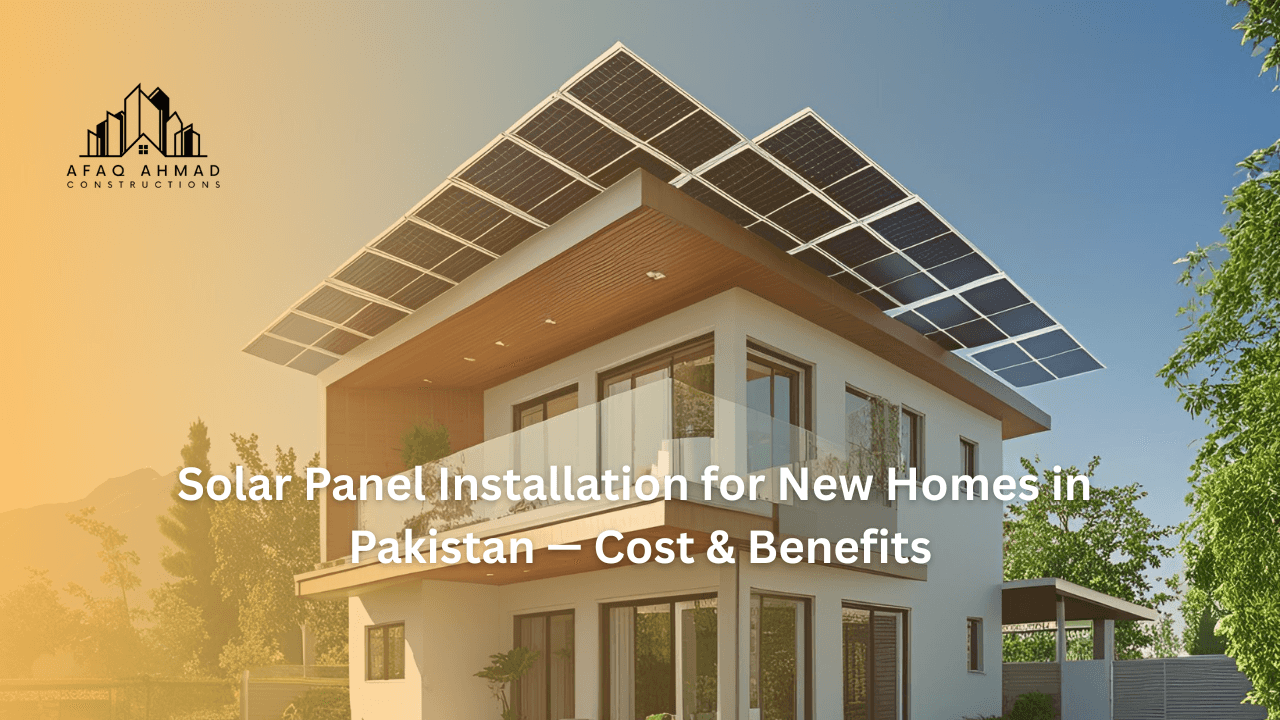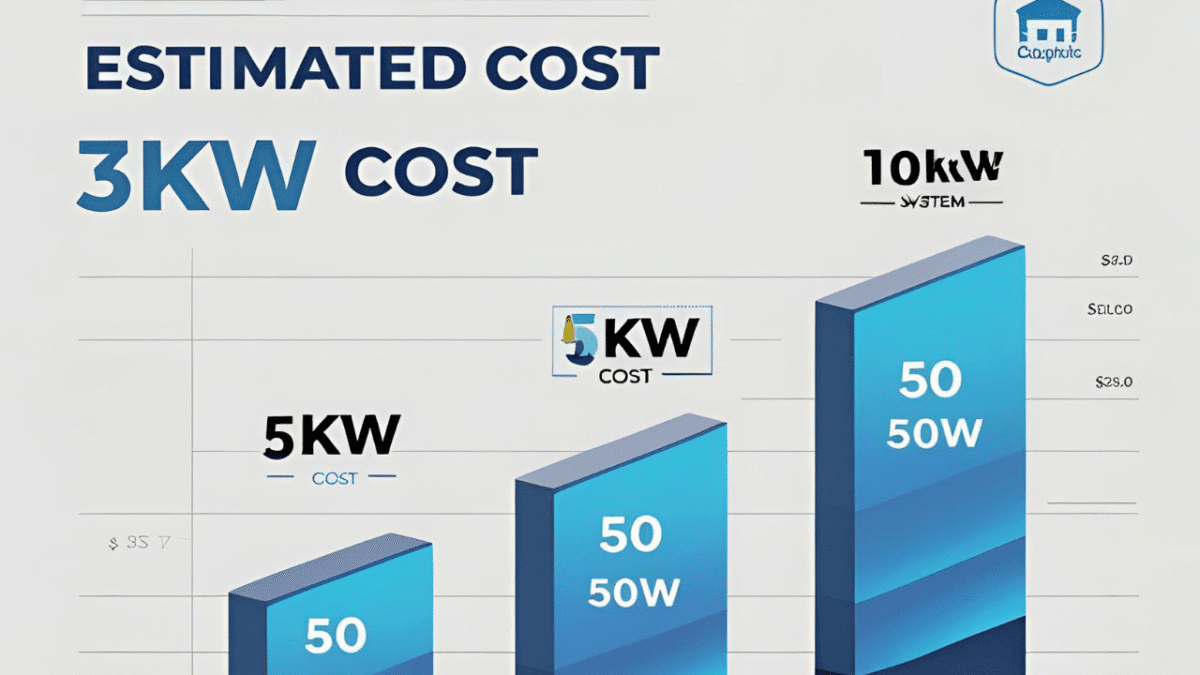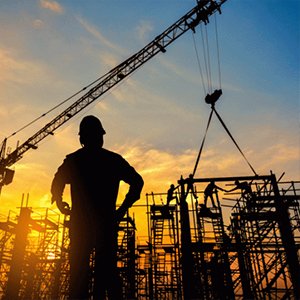
Top Home Security Tips for New Constructions in Pakistan
July 31, 2025
How to Choose the Right Tiles for Pakistani Homes (2025 Trends)
August 6, 2025
The construction sector is thriving with a projected real estate growth rate of over 5% annually from 2025 to 2028. With a housing deficit exceeding 10 million units, new homes are sprouting in areas like DHA Lahore, Bahria Town, and Lahore Smart City. Amid rising electricity costs (averaging PKR 25-30/kWh) and load-shedding, solar panel installation is gaining traction. At Afaq Ahmad Constructions, we’ve guided homeowners in integrating solar solutions for their 10 Marla homes (PKR 16.3-20 million). This blog explores the cost & benefits of solar panel installation for new homes in Pakistan, tailored for 2025.
Why Solar Panels Matter in 2025
Lahore’s sunny climate, with 8-10 peak sun hours daily, makes solar energy viable, despite monsoon rains (600-800 mm, July-August) and 40°C summers, as noted in our weather blog. The Pakistan Building Code (PBC) 2021 and Green Building Code 2023 encourage renewable energy, while material costs (e.g., cement at PKR 1,060 per bag) and labor rates (PKR 450/day) shape budgets, per our cost and timeline blogs. Solar panels can cut electricity bills by PKR 50,000-100,000 annually and add 10-15% to property value, aligning with our sustainable guide. Let’s dive into the details.
Understanding Solar Panel Installation
How It Works
- Components: Solar panels, inverters, batteries, and mounting structures convert sunlight into electricity.
- Types: Monocrystalline (20-22% efficiency), polycrystalline (15-17%), and thin-film (10-12%).
- Capacity: A 10 Marla home (2,722 sq ft) typically needs 5-10 kW, depending on usage.
Government Incentives
- Net Metering: Allows excess power to be sold back to the grid, per NEPRA policies updated in 2025.
- Subsidies: Up to 20-30% off equipment costs for residential projects under the PM Solar Initiative.
- Tax Breaks: Exemptions on import duties for solar components.
Step-by-Step Guide to Installation
1. Assess Energy Needs
- Step: Calculate daily electricity consumption (e.g., 20-30 kWh for a 10 Marla home).
- Details: Account for ACs, lights, and appliances; use a meter (PKR 2,000-5,000) or past bills.
- Timeline: 1-2 days.
- Cost: Free with consultation from Afaq Ahmad Constructions.
- Tip: Plan for future expansion (e.g., EV charging), per our modular blog.
2. Evaluate Roof Space and Orientation
- Step: Measure available roof area and ensure south-facing alignment for maximum sun exposure.
- Details: A 5 kW system needs 300-400 sq ft; avoid shading from trees or adjacent buildings.
- Timeline: 1-2 days, per our supervision blog.
- Cost: PKR 10,000-20,000 for a surveyor.
- Tip: Slope roofs at 10-15° for rainwater runoff, per our waterproofing blog.

3. Choose the Right System
- Step: Select panel type, capacity, and battery backup based on budget and needs.
- Details: Monocrystalline panels (PKR 50-70/Watt) for efficiency; 5 kWh lithium batteries (PKR 200,000-300,000) for backup.
- Timeline: 1 week for decision-making.
- Cost: PKR 500,000-1 million for 5 kW, per market rates.
- Tip: Opt for hybrid inverters (PKR 100,000-150,000) for grid-tie flexibility.
4. Obtain Approvals and Permits
- Step: Apply for net metering and local authority clearance.
- Details: Submit to LESCO or FESCO (PKR 10,000-20,000 fees) and comply with PBC 2021.
- Timeline: 2-4 weeks, per our regulations blog.
- Cost: PKR 20,000-50,000, including documentation.
- Tip: Use Afaq Ahmad Constructions to streamline the process.
5. Install the System
- Step: Mount panels, connect wiring, and set up inverters and batteries.
- Details: Hire certified installers (PKR 50,000-100,000 labor) for a 5 kW system during finishing (12-16 weeks).
- Timeline: 1-2 weeks, per our timeline blog.
- Cost: Included in system cost (PKR 500,000-1 million).
- Tip: Use corrosion-resistant mounts (PKR 20,000-40,000) for monsoon durability.
6. Test and Maintain
- Step: Conduct performance tests and schedule annual maintenance.
- Details: Check output (e.g., 20-25 kWh/day) and clean panels (PKR 5,000-10,000/year).
- Timeline: 1 day for testing; yearly checks.
- Cost: PKR 10,000-20,000/year, per our renovation blog.
- Tip: Monitor via apps for real-time data, per our smart home trends.
Cost Breakdown for 2025
Initial Investment
- Panels: 5 kW x PKR 60/Watt = PKR 300,000.
- Inverter: PKR 100,000-150,000.
- Batteries: 5 kWh x PKR 50,000 = PKR 250,000.
- Mounting and Wiring: PKR 50,000-100,000.
- Installation and Permits: PKR 70,000-150,000.
- Total: PKR 770,000-950,000 for 5 kW (with subsidy: PKR 540,000-665,000).
Long-Term Costs
- Maintenance: PKR 10,000-20,000/year.
- Replacement: Batteries every 5-7 years (PKR 200,000-300,000); panels every 20-25 years (PKR 300,000-400,000).
Benefits of Solar Panels
Financial Savings
- Electricity Bills: Reduces PKR 50,000-100,000/year (at 25 kWh/day x PKR 25/kWh).
- Payback Period: 4-6 years with subsidies; 6-8 without.
- ROI: 15-20% over 20 years, adding PKR 2.5-4 million to property value.

Environmental Impact
- Carbon Footprint: Cuts 3-5 tons of CO2 annually, aligning with Green Building Code 2023.
- Energy Independence: Mitigates load-shedding, enhancing livability.
Durability and Resilience
- Weather Resistance: Withstands 40°C heat and monsoons if installed correctly, per our weather blog.
- Longevity: 20-25 year warranty on panels, per our QA blog.
Challenges and Solutions in 2025
Challenges
- Cost Overruns: Initial investment adds 5-10% to budgets (PKR 800,000-1 million).
- Weather Delays: Monsoons (July-August) hinder installation, adding 2-4 weeks, per our weather blog.
- Skill Shortage: Labor lacks expertise in solar systems.
- Grid Issues: Inconsistent net metering delays returns.
Solutions
- Budget Planning: Use our cost guide to allocate a 10-15% buffer (PKR 1.6-3 million).
- Weather Adaptation: Schedule during dry months (October-March), saving 2-4 weeks.
- Training: Partner with Afaq Ahmad Constructions for certified installers.
- Advocacy: Follow up with LESCO for net metering, per our regulations blog.
2025 Market Context
- Demand: High interest in DHA Lahore and Bahria Town for sustainable homes.
- Trends: Solar adoption rises 20-30% in 2025, per our sustainable guide.
- Costs: Material hikes (5-7%) affect budgets; labor shortages delay projects.
- Solution: Leverage Afaq Ahmad Constructions for seamless integration.
Visualizing Solar Power
Imagine a 10 Marla home in Bahria Town, its roof lined with monocrystalline panels (our roofing image), powering a DHA Lahore villa’s ACs (our villa image). Picture a renovated Model Town bungalow with a hybrid system (our bungalow image). Afaq Ahmad Constructions ensures your solar setup shines.
The Role of Afaq Ahmad Constructions
At Afaq Ahmad Constructions, we power your home:
- Expert Planning: We assess needs and design systems.
- Quality Installation: We meet PBC and Green Building Code standards.
- Support: We handle permits and maintenance.
Visit https://afaqahmadconstructions.com/ to start your solar project today!
Conclusion
Solar panel installation for new homes in Pakistan in 2025 offers a cost-effective (PKR 540,000-950,000 for 5 kW) and beneficial solution, cutting electricity bills by PKR 50,000-100,000/year and adding PKR 2.5-4 million to a 10 Marla home’s value. By assessing needs, evaluating space, choosing systems, obtaining approvals, installing, and maintaining, you ensure efficiency and compliance with PBC 2021. Trust Afaq Ahmad Constructions to guide you with expertise. Contact us now to go solar!





